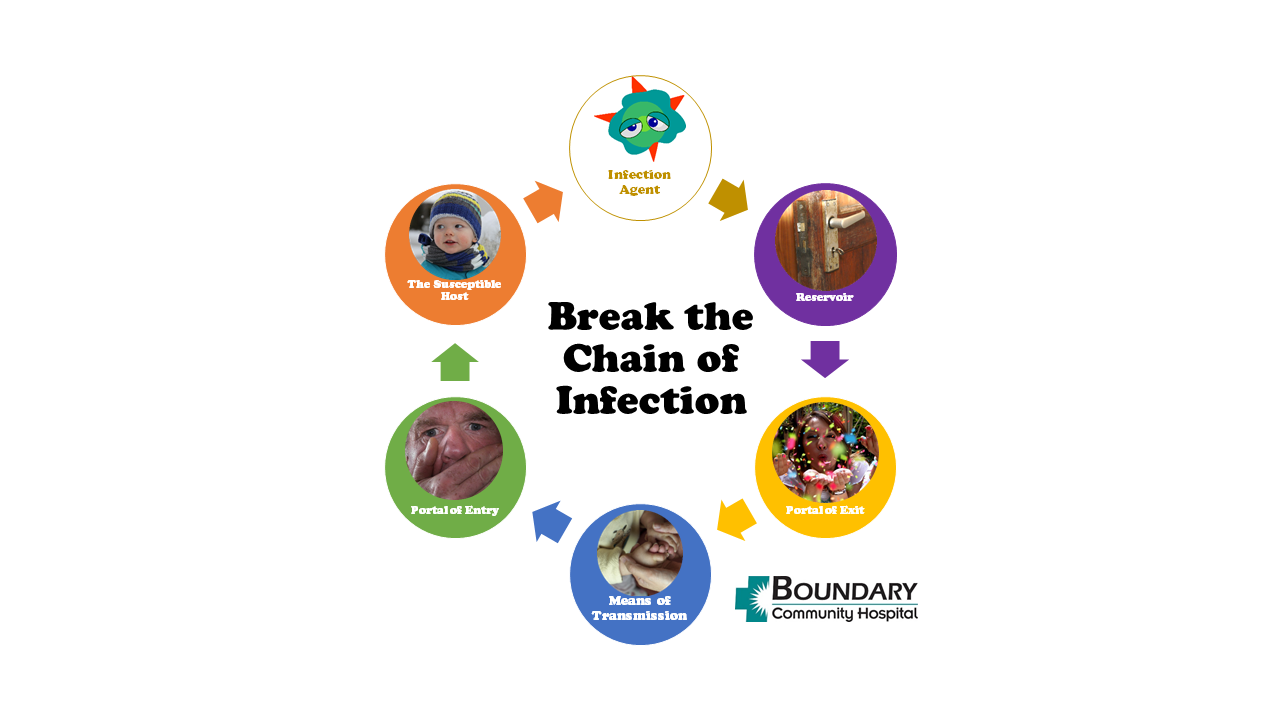 By: Connie Sue Clum, RN, MSN
By: Connie Sue Clum, RN, MSN
Infection Prevention Nurse
Boundary Community Hospital
Bonners Ferry, ID – With the seasons changing, it is an excellent time to remind everyone that each of you play an important role in infection prevention. Despite the variety of viruses and bacteria, germs spread from person to person through a common series of events. Therefore, to prevent germs from infecting more people, we must break the chain of infection.
No matter the germ, there are six points at which the chain can be broken and a germ can be stopped from infecting another person. The six links include:
- The infectious agent is the pathogen (germ) that causes the disease.
- The reservoir is the place in the environment where the pathogen lives. This includes people, animals and insects, medical equipment, your countertop or any object in your home, soil and water.
- The portal of exit is the way the infectious agent leaves the reservoir. This could be through open wounds, aerosols, and the splatter of body fluids including coughing, sneezing, and saliva.
- The means of transmission is the way the infectious agent can be passed on. This could be through direct contact like touching, ingestion into the stomach, or inhalation into the nasal cavity or lungs.
- The portal of entry is the way the infectious agent can enter a new host. In contrast to the means of transmission (which is the movement of the germ from the object to you or another person), the portal of entry is the actual entering of the body. This can be through broken skin, the respiratory tract (nose or lungs), mucous membranes (including the urine), and catheters and tubes.
- Lastly, the susceptible host can be any person. The most vulnerable are those receiving healthcare, are immunocompromised, or have invasive medical devices including lines, devices, and airways.
Imagine all of these links in a circle. A germ can travel around this circle very quickly. The way to stop germs from spreading is by interrupting this chain (or circle) at any spot. There are many ways to do this.
 Here are some common sense tips to interrupt the chain and reduce your chances of spreading germs:
Here are some common sense tips to interrupt the chain and reduce your chances of spreading germs:
- The most important is cleaning your hands You can use hand sanitizer but the best way to clean your hands is soap and water.
- Getting your flu shot If you are over 65, you can get the Prevnar 13 (recommended to get first) or the Pneumovax vaccines to help prevent pneumonia.
- Covering coughs and sneezes and staying home when sick are other important ways of stopping the spread of germs. Did you know coughing or sneezing into your elbow or shoulder is one of the best ways to cover your cough?
- At home, cleaning and disinfecting high touch surfaces is important. High touch surfaces are items like countertops, sink and toilet seat handles, computer keyboards or any other surfaces that you touch frequently with your hands.
Be honest: Have you ever used your scarf or gloves to wipe your nose or cover a sneeze/cough when a tissue wasn’t available? Oh, my! And then with your runny nose-contaminated glove, you touch a steering wheel, doorknob, or seat—all the time spreading the germs to others. Remember to wash your gloves and scarves on a regular basis, preferably once per week or when soiled. Most germs will survive for two or three days on inanimate objects—some longer. They don’t have to look soiled or smell bad to be loaded with germs either!
Stopping the spread of germs is key to staying healthy. Interrupting the chain at some point on the link, will keep you healthier this year. Now you are an Infection Preventionist too!
